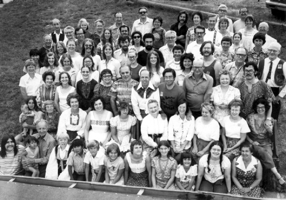
|
The Society of Folk Dance Historians (SFDH) Lighted Lantern Folk Dance Camp
[
Home |
About |
Encyclopedia | THIS IS HISTORICAL INFORMATION ONLY CLICK AN IMAGE TO ENLARGE |

|
 Information: A Folk Dance camp (1948-1978).
Information: A Folk Dance camp (1948-1978).
In 1944, a group of five people pooled their money for an initial payment to purchase the title of the old Flying Horse Inn, 22 miles due west of Denver, Colorado. The inn, which included a lodge and four cabins, was situated at 7,460 feet in elevation atop Lookout Mountain at the western edge of the historic town of Golden. The five, Fred Enholm, Pauline Kermiet, Lila Parke, Mary Segeuin, and Kathleen Timmons, renamed the old inn "Lighted Lantern."
The five new owners and their spouses were closely allied in the program efforts at Steele Community Center in Denver, Colorado. These groups represented, among others, art, crafts, drawing, dancing, music, and athletics, as well as the Sherwood Folk Dancers. Frederick G. Enholm was the staff administrator and program director at Steele (his wife's name was Mary). Pauline R. Kermiet was a staff assistant and a volunteer (Pauline's husband, Paul, was on leave from Steele because of the War). Lila Lynn Parke was a drama and play production volunteer at Steele. Mary Seguin, a university student, was another Steele volunteer. Kathleen Timmons also was a Steele staff assistant and a group leader. While the entire group contributed much labor, leadership, and planning to the Lantern enterprise, operation of the "Lantern" (as it became fondly known) began to be placed heavily on Paul and Pauline Kermiet as the key people responsible for every-day operation. Eventually, in return for their services, the Kermiets began to receive a percentage of the income from fees and rentals.
The purpose of the new Lighted Lantern camp was to be an enrichment opportunity for the many activity groups that had their beginnings at Steele. Care was taken to have an open door to all who wanted to attend. Because the Lantern was purchased during World War II, budgets were tight, and the vision was to accommodate small groups. While smaller groups were the norm in the early years, groups at the Lantern were soon numbering a hundred or more.
The owners, spouses, some paid help, and a bevy of volunteers constructed several more buildings. The Lighted Lantern enterprise was established as a contribution in community social service, not for eventual sale to make a profit. Group members agreed to affiliate under such an arrangement, with the understanding that their labor was to be contributed and money loaned to further the enterprise would repaid out of operational income. The owners never applied for tax-exempt status.
One by one, the original owners began to die or move away. Lila Parke died and Mary Seguin moved to California (while remaining a silent partner), leaving the Enholms and Kermiets to carry the load. In 1958, an irrevocable trust was set up by the three remaining members of the group. The trust stipulated that the beneficiary was to be the American Friends Service Committee (Quakers). During negotiations, Kathleen Timmons also died.
After 31 years, although the loan payments had nearly been completed, it was decided that Lantern operations would be terminated after the 1975 season and turned over to the American Friends unless some way developed to have the property operated under someone other than the original group.
The Lighted Lantern Folk Dance week actually was viable for another two years.
TEACHERS BY YEAR
- 1959 – Bruce McClure, Paul & Gretel Dunsing, Paul & Pauline Kermiet, .
- 1960 – Annemargaret Ulrich, Jerry Joris, Paul & Pauline Kermiet, Fay & Dru Feree, Fred & Mary Enholm.
- 1961 – Jerry Joris, Jack & Shirley Burks, Paul & Pauline Kermiet, Fay & Dru Feree, Fred & Mary Enholm.
- 1962 – Jerry Joris, Jack & Shirley Burks, Paul & Pauline Kermiet, Fay & Dru Feree, Fred & Mary Enholm.
- 1963 – Jerry Joris, Paul & Pauline Kermiet, Fay & Dru Feree, Fred & Mary Enholm.
- 1964 – Jerry Joris, Paul & Pauline Kermiet, Fay & Dru Feree, Fred & Mary Enholm.
- 1965 – Jerry Joris, Paul & Pauline Kermiet, Fay & Dru Feree, Fred & Mary Enholm.
- 1966 – Jerry Joris, Dottie Skala, Paul & Pauline Kermiet, Fred & Mary Enholm.
- 1967 – Jerry Joris, Paul & Pauline Kermiet, Betty Schuh, Jerry Hamilton, Hal Barnes.
- 1968 – Jerry Joris, Dottie Skala, Rudy Ulibarrí, Dick Forscher, Paul & Pauline Kermiet, Fay & Dru Feree.
- 1969 – Jerry Joris, Dottie Skala, Rudy Ulibarrí, Dick Forscher, Paul & Pauline Kermiet, Fay & Dru Feree.
- 1970 – Jane Farwell, Rudy Ulibarrí, Hervert Witttenberg, Fay & Dru Feree.
- 1971 – Jerry Joris, Dottie Skala, Rudy Ulibarrí, C. Stewart Smith, Fay & Dru Feree, Fred & Mary Enholm.
- 1972 – Jane Farwell, Ingvar & Jofrid Sodal, Rudy Ulibarrí, Fay & Dru Feree.
- 1973 – Athan Karras, Rudy Ulibarrí, Dick Oakes, Fay & Dru Feree, Fred & Mary Enholm.
- 1974 – Gretel Dunsing, Nelda Drury, Rudy Ulibarrí, Dick Oakes, Jim Graham, Fay & Dru Feree, Fred & Mary Enholm
- 1975 – (Week One) Jerry Joris, Gretel Dunsing, Vyts Beliajus, Ya'akov Eden, Jim Graham, Rudy Ulibarrí, Dick Oakes, Fay & Dru Feree, Fred & Mary Enholm.
- 1975 – (Week Two) Vyts Beliajus, Ya'akov Eden, Gretel Dunsing, Jim Graham, Fay & Dru Feree, Fred & Mary Enholm.
- 1976 – Rudy Ulibarrí, Dick Oakes, Jim Graham, Fay & Dru Feree, Fred & Mary Enholm.
- 1977 – Rudy Ulibarrí, Dick Oakes, Peter Eccles, Fay & Dru Feree, Fred & Mary Enholm.
This page © 2018 by Ron Houston.
Please do not copy any part of this page without including this copyright notice.
Please do not copy small portions out of context.
Please do not copy large portions without permission from Ron Houston.